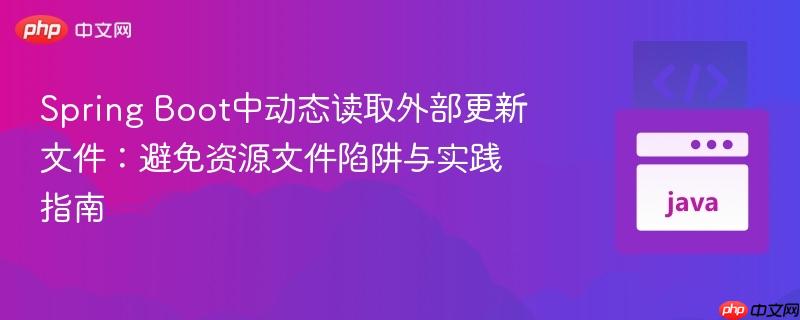
本教程深入探讨了spring boot应用中动态读取持续更新文件的最佳实践,着重解决将文件置于src/main/resources导致的静态资源问题。文章将指导您如何将文件路径外部化配置,并结合@scheduled注解实现周期性数据读取与数据库更新,同时优化代码结构、依赖注入方式,并提供完整的示例与注意事项。
在Spring Boot应用开发中,开发者常将配置文件、模板文件等静态资源放置于src/main/resources目录下。当应用打包成JAR或WAR文件时,这些资源会被嵌入到最终的可执行文件中。通过ClassLoader.getResourceAsStream()或Class.getResourceAsStream()方法读取的,实际上是JAR/WAR内部的资源流。
这种机制对于静态资源非常有效,但对于需要“持续更新”的文件则会带来问题。一旦文件被打包进JAR/WAR,它就成为了应用的一部分,无法在运行时被外部修改。即使外部文件系统上的同名文件发生了变化,应用内部通过getResourceAsStream读取到的仍然是打包时包含的旧版本内容。这就是为什么即使JSON文件在外部被更新,@Scheduled任务也只会读取到相同(过时)数据的原因。
因此,若文件需要动态更新且其内容需被应用实时感知,它就不能作为应用内部的资源文件存在。
解决动态文件读取问题的关键在于将文件从应用程序的内部资源中“外部化”,即将其放置在文件系统上的一个独立位置,并通过配置项告知应用程序其路径。
推荐在application.properties或application.yml中定义文件路径。这使得路径易于管理,并且可以在不同环境(开发、测试、生产)中轻松切换。
application.properties示例:
# 定义外部JSON文件的路径 # 建议使用绝对路径或相对于应用启动目录的相对路径 app.data.json-path=/path/to/your/external/json/file.json
在Spring组件中,可以使用@Value注解将配置的路径注入进来,然后使用标准的Java I/O API(如java.nio.file.Files或java.io.FileInputStream)来读取文件内容。
import org.springframework.beans.factory.annotation.Value;
import org.springframework.stereotype.Component;
import java.io.IOException;
import java.nio.file.Files;
import java.nio.file.Path;
import java.nio.file.Paths;
@Component
public class ExternalFileReader {
@Value("${app.data.json-path}")
private String jsonFilePath;
public String readExternalJsonFile() throws IOException {
Path path = Paths.get(jsonFilePath);
// 检查文件是否存在且可读
if (!Files.exists(path) || !Files.isReadable(path)) {
throw new IOException("JSON file not found or not readable at: " + jsonFilePath);
}
return new String(Files.readAllBytes(path));
}
}一旦文件路径外部化并能正确读取,就可以结合@Scheduled注解实现周期性地读取文件内容并更新数据库。
确保Spring Boot主应用类上添加@EnableScheduling注解以启用定时任务功能。
import org.springframework.boot.SpringApplication;
import org.springframework.boot.autoconfigure.SpringBootApplication;
import org.springframework.scheduling.annotation.EnableScheduling;
@SpringBootApplication
@EnableScheduling // 启用定时任务
public class ReadAndWriteJsonApplication {
public static void main(String[] args) {
SpringApplication.run(ReadAndWriteJsonApplication.class, args);
}
}将读取、解析和保存数据的逻辑封装到一个独立的Spring组件中。这有助于保持主应用类的简洁性,并提高代码的可维护性。
package com.example.demo.component; // 建议放在一个独立的包中
import com.example.demo.Services.MasterService;
import com.example.demo.model.Master;
import com.fasterxml.jackson.core.type.TypeReference;
import com.fasterxml.jackson.databind.ObjectMapper;
import org.springframework.beans.factory.annotation.Value;
import org.springframework.scheduling.annotation.Scheduled;
import org.springframework.stereotype.Component;
import org.springframework.transaction.annotation.Transactional; // 确保事务一致性
import java.io.IOException;
import java.nio.file.Files;
import java.nio.file.Path;
import java.nio.file.Paths;
import java.util.List;
@Component
public class JsonDataSyncScheduler {
private final MasterService masterService;
private final ObjectMapper objectMapper; // 使用ObjectMapper进行JSON解析
@Value("${app.data.json-path}")
private String jsonFilePath;
// 推荐使用构造器注入
public JsonDataSyncScheduler(MasterService masterService, ObjectMapper objectMapper) {
this.masterService = masterService;
this.objectMapper = objectMapper;
}
@Scheduled(fixedRate = 90000) // 每90秒执行一次
@Transactional // 确保数据库操作的原子性
public void syncJsonDataToDatabase() {
System.out.println("Scheduled task: Attempting to sync JSON data...");
try {
// 1. 从外部文件路径读取内容
Path path = Paths.get(jsonFilePath);
if (!Files.exists(path) || !Files.isReadable(path)) {
System.err.println("Error: JSON file not found or not readable at: " + jsonFilePath);
return;
}
String jsonContent = new String(Files.readAllBytes(path));
// 2. 解析JSON内容
TypeReference<List<Master>> typeReference = new TypeReference<List<Master>>(){};
List<Master> masters = objectMapper.readValue(jsonContent, typeReference);
// 3. 将数据保存到数据库
if (masters != null && !masters.isEmpty()) {
masterService.saveAll(masters); // 假设MasterService有一个saveAll方法
System.out.println("Successfully synced " + masters.size() + " records from JSON to database.");
} else {
System.out.println("No records found in JSON file or JSON file is empty.");
}
} catch (IOException e) {
System.err.println("Error reading or parsing JSON file: " + e.getMessage());
} catch (Exception e) {
System.err.println("Error during database sync: " + e.getMessage());
e.printStackTrace();
}
}
}Spring官方推荐使用构造器注入(Constructor Injection)而非字段注入(Field Injection)。构造器注入使得依赖关系更加明确,易于测试,并有助于避免循环依赖问题。
MasterService类示例:
package com.example.demo.Services;
import com.example.demo.Repository.MasterRepository;
import com.example.demo.model.Master;
import org.springframework.stereotype.Service;
import org.springframework.transaction.annotation.Transactional;
import java.util.List;
@Service
public class MasterService {
private final MasterRepository masterRepository;
// 推荐使用构造器注入
public MasterService(MasterRepository masterRepository) {
this.masterRepository = masterRepository;
}
public Iterable<Master> list() {
return masterRepository.findAll();
}
@Transactional // 确保单个Master保存的事务性
public Master save(Master master){
return masterRepository.save(master);
}
@Transactional // 确保批量Master保存的事务性
public Iterable<Master> saveAll(List<Master> masters) {
return masterRepository.saveAll(masters);
}
}对于涉及数据库写入的操作,务必使用@Transactional注解来确保数据的一致性和完整性。在批量保存或更新时,如果其中一条记录失败,整个事务可以回滚,避免部分数据写入的情况。
在文件I/O和JSON解析过程中,应捕获IOException和其他潜在异常,并进行适当的日志记录或错误处理,以提高应用程序的健壮性。
以下是整合了上述最佳实践和解决方案的完整代码结构:
1. application.properties
# 定义外部JSON文件的路径 # 请根据您的实际情况修改此路径 app.data.json-path=/Users/youruser/data/file.json # 或者在Windows上:app.data.json-path=C:/data/file.json # 如果是相对路径,例如相对于jar包启动目录下的data文件夹:app.data.json-path=./data/file.json # 数据库配置 (示例,请根据实际数据库类型配置) spring.datasource.url=jdbc:h2:mem:testdb spring.datasource.driverClassName=org.h2.Driver spring.datasource.username=sa spring.datasource.password=password spring.jpa.database-platform=org.hibernate.dialect.H2Dialect spring.jpa.hibernate.ddl-auto=update
2. Master Model (假设已存在,这里提供一个简单示例)
package com.example.demo.model;
import lombok.Data;
import lombok.NoArgsConstructor;
import lombok.AllArgsConstructor;
import javax.persistence.Entity;
import javax.persistence.GeneratedValue;
import javax.persistence.GenerationType;
import javax.persistence.Id;
@Data
@NoArgsConstructor
@AllArgsConstructor
@Entity
public class Master {
@Id
@GeneratedValue(strategy = GenerationType.IDENTITY)
private Long id;
private String name;
private String email;
// 其他字段...
}3. MasterRepository
package com.example.demo.Repository;
import com.example.demo.model.Master;
import org.springframework.data.repository.CrudRepository;
import org.springframework.stereotype.Repository;
@Repository
public interface MasterRepository extends CrudRepository<Master, Long> {
}4. MasterService
package com.example.demo.Services;
import com.example.demo.Repository.MasterRepository;
import com.example.demo.model.Master;
import org.springframework.stereotype.Service;
import org.springframework.transaction.annotation.Transactional;
import java.util.List;
@Service
public class MasterService {
private final MasterRepository masterRepository;
public MasterService(MasterRepository masterRepository) {
this.masterRepository = masterRepository;
}
public Iterable<Master> list() {
return masterRepository.findAll();
}
@Transactional
public Master save(Master master){
return masterRepository.save(master);
}
@Transactional
public Iterable<Master> saveAll(List<Master> masters) {
return masterRepository.saveAll(masters);
}
}5. JsonDataSyncScheduler
package com.example.demo.component;
import com.example.demo.Services.MasterService;
import com.example.demo.model.Master;
import com.fasterxml.jackson.core.type.TypeReference;
import com.fasterxml.jackson.databind.ObjectMapper;
import org.springframework.beans.factory.annotation.Value;
import org.springframework.scheduling.annotation.Scheduled;
import org.springframework.stereotype.Component;
import org.springframework.transaction.annotation.Transactional;
import java.io.IOException;
import java.nio.file.Files;
import java.nio.file.Path;
import java.nio.file.Paths;
import java.util.List;
@Component
public class JsonDataSyncScheduler {
private final MasterService masterService;
private final ObjectMapper objectMapper;
@Value("${app.data.json-path}")
private String jsonFilePath;
public JsonDataSyncScheduler(MasterService masterService, ObjectMapper objectMapper) {
this.masterService = masterService;
this.objectMapper = objectMapper;
}
@Scheduled(fixedRate = 90000) // 每90秒执行一次
@Transactional // 确保数据库操作的原子性
public void syncJsonDataToDatabase() {
System.out.println("Scheduled task: Attempting to sync JSON data...");
try {
Path path = Paths.get(jsonFilePath);
if (!Files.exists(path) || !Files.isReadable(path)) {
System.err.println("Error: JSON file not found or not readable at: " + jsonFilePath);
return;
}
String jsonContent = new String(Files.readAllBytes(path));
TypeReference<List<Master>> typeReference = new TypeReference<List<Master>>(){};
List<Master> masters = objectMapper.readValue(jsonContent, typeReference);
if (masters != null && !masters.isEmpty()) {
masterService.saveAll(masters);
System.out.println("Successfully synced " + masters.size() + " records from JSON to database.");
} else {
System.out.println("No records found in JSON file or JSON file is empty.");
}
} catch (IOException e) {
System.err.println("Error reading or parsing JSON file: " + e.getMessage());
} catch (Exception e) {
System.err.println("Error during database sync: " + e.getMessage());
e.printStackTrace();
}
}
}6. ReadAndWriteJsonApplication (主应用类)
package com.example.demo;
import org.springframework.boot.SpringApplication;
import org.springframework.boot.autoconfigure.SpringBootApplication;
import org.springframework.scheduling.annotation.EnableScheduling;
import org.springframework.transaction.annotation.EnableTransactionManagement;
@SpringBootApplication
@EnableScheduling
@EnableTransactionManagement // 启用事务管理
public class ReadAndWriteJsonApplication {
public static void main(String[] args) {
SpringApplication.run(ReadAndWriteJsonApplication.class, args);
}
}7. 示例JSON文件 (/Users/youruser/data/file.json 或您配置的路径)
[
{
"id": 1,
"name": "Alice",
"email": "alice@example.com"
},
{
"id": 2,
"name": "Bob",
"email": "bob@example.com"
}
]当您更新此JSON文件并保存后,Spring Boot应用程序将在下一个90秒周期内读取到最新的内容并更新数据库。
以上就是Spring Boot中动态读取外部更新文件:避免资源文件陷阱与实践指南的详细内容,更多请关注php中文网其它相关文章!

每个人都需要一台速度更快、更稳定的 PC。随着时间的推移,垃圾文件、旧注册表数据和不必要的后台进程会占用资源并降低性能。幸运的是,许多工具可以让 Windows 保持平稳运行。

Copyright 2014-2025 https://www.php.cn/ All Rights Reserved | php.cn | 湘ICP备2023035733号